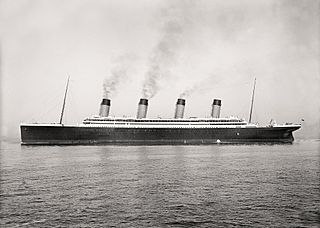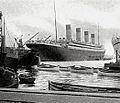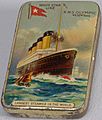RMS Olympic facts for kids
|
RMS Olympic on her sea trials in Belfast in 1911
|
|
Quick facts for kids History |
|
|---|---|
| Name | Olympic |
| Owner |
|
| Port of registry | Liverpool, United Kingdom |
| Route | Southampton to New York City |
| Ordered | 1907 |
| Builder | Harland and Wolff, Belfast |
| Cost | $7.5 million (USD) ($195.1 million in 2018) |
| Yard number | 400 |
| Laid down | 16 December 1908 |
| Launched | 20 October 1910 |
| Completed | 31 May 1911 |
| Acquired | 31 May 1911 |
| Maiden voyage | 14 June 1911 |
| In service | 1911 |
| Out of service | 1935 |
| Identification | |
| Fate | Retired at Southampton after 24 years service & scrapped. Superstructure dismantled at Jarrow, England, and the hull at Inverkeithing, Scotland. |
| Status | Scrapped |
| General characteristics | |
| Class and type | Olympic-class ocean liner |
| Tonnage | 45,324 gross register tons; 46,358 after 1913; 46,439 after 1920 |
| Displacement | 52,067 tons |
| Length | 882 ft 9 in (269.1 m) |
| Beam | 92 ft 9 in (28.3 m) |
| Height | 175 ft (53.4 m) (keel to top of funnels) |
| Draught | 34 ft 7 in (10.5 m) |
| Decks | 9 decks (8 for passengers and 1 for crew) |
| Installed power | 24 double-ended (six furnace) and 5 single-ended (three furnace) Scotch boilers. Two four-cylinder triple-expansion reciprocating engines each producing 15,000 hp for the two outboard wing propellers at 75 revolutions per minute. One low-pressure turbine producing 16,000 h. 59,000 hp produced at maximum revolutions. |
| Propulsion | Two bronze three-bladed wing propellers. One bronze four-bladed centre propeller. |
| Speed |
|
| Capacity | 2,435 passengers |
| Crew | 950 |
| Notes | First in a trio of Olympic-class ocean liners for White Star Line and the only one to have a successful career. Elder sister to RMS Titanic and HMHS Britannic. |
RMS Olympic was a huge British ship. It was an ocean liner, which means it carried passengers across the Atlantic Ocean. It was the first of three famous ships built by the White Star Line.
Unlike its sister ships, Olympic had a very long career. It sailed for 24 years, from 1911 to 1935. During World War I, it even served as a troopship, carrying soldiers. This earned it the nickname "Old Reliable." After the war, Olympic went back to being a passenger ship. It sailed successfully through the 1920s. However, by the 1930s, it became too expensive to operate. This was due to new ships and the Great Depression.
Olympic was the biggest ocean liner in the world for a while. This was between 1911 and 1913. Its sister ship, Titanic, was briefly larger. Titanic had the same size but more space inside. Olympic was also the largest British-built liner until 1934. That's when the RMS Queen Mary was launched.
The Olympic was taken out of service in 1935. It was then sold for scrap metal. Its demolition was finished in 1937. Before it was scrapped, many beautiful parts of Olympic were saved. They were sold and now decorate buildings and even a cruise ship.
Olympic's sister ships, Titanic and Britannic, did not have long lives. Titanic hit an iceberg and sank on its first trip. This happened in the Atlantic Ocean. Britannic hit a mine and sank in Greece in 1916. Britannic never even got to carry passengers.
Contents
Building a Giant Ship
The Olympic was built by Harland and Wolff in Belfast. It was ordered in 1907. The ship was very large for its time. Its construction started in December 1908. It was launched into the water in October 1910. The ship was finished in May 1911.
Life as an Ocean Liner
Olympic began its first journey on June 14, 1911. It sailed from Southampton to New York City. It was a very popular ship. Passengers enjoyed its grand interiors. It had a famous Grand Staircase.
World War I Service
When World War I started in 1914, Olympic was still a passenger ship. But soon, it was called to help. It became a troopship. This meant it carried soldiers across the ocean. It was painted grey to make it harder for enemies to see.
Olympic was very good at its job. It safely carried many thousands of soldiers. It even helped rescue sailors from a sinking British battleship. This is why it was called "Old Reliable."
Return to Passenger Service
After the war, Olympic went back to carrying passengers. It was refitted and updated. It continued to sail between England and New York. It was still a very popular ship in the 1920s.
Later Years and Retirement
By the early 1930s, times were changing. The Great Depression meant fewer people could afford to travel. Also, newer, faster ships were being built. Olympic became less profitable. In 1934, it was involved in a small accident. It hit a lightship near Nantucket.
In 1935, after 24 years of service, Olympic was retired. It was then sold to be taken apart. Its parts were recycled. This marked the end of a long and successful career for the "Old Reliable."
Images for kids
-
Olympic photographed near the Isle of Wight in October 1912, six months after the Titanic disaster
-
Olympic in dazzle camouflage at Pier 2 in Halifax, Nova Scotia painted by Arthur Lismer
-
Olympic (left) and Mauretania (right) laid up in Southampton before they were scrapped.
-
Olympic arriving at Jarrow for scrapping on 13 October 1935
See also
 In Spanish: RMS Olympic para niños
In Spanish: RMS Olympic para niños

























